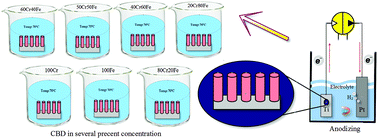Preparation and characterization of CrFeWTiO2 photoanodes and their photoelectrochemical activities for water splitting
Abstract
The chemical bath deposition (CBD) method was successfully applied to prepare WTiO2 nanotube arrays co-deposited with chromium, iron and chromium–iron nanoparticles. Various methods have been used in the characterization of synthetic co-deposited nanostructures. WTiO2 nanotubes can keep the nanotubular structures at low iron concentration in the CBD solution, as indicated by our FESEM results. Iron and chromium can be applied to improve the absorption capability of the WTiO2 nanotubes for the visible-light, according to the UV-Vis results. Based on the photoelectrochemical performance and photocatalytic hydrogen evolution characteristics of the CrFeWTiO2 catalysts, the co-deposited nanoparticles contribute to the improvement in the photocatalytic efficiency. The best photocatalytic activity was shown by the CrFeWTiO2-1 sample formed by immersion in a CBD solution containing 0.08 M ClCl3·6H2O + 0.02 M FeCl3·6H2O. The hydrogen evolution reaction of the new photocatalysts showed that their photocatalytic activity was very stable. A facile method has been developed in this study for the synthesis of high performance co-deposited photocatalysts with excellent stability and reliability in photoelectrochemical water splitting. A stable and high photocatalytic activity for hydrogen evolution in the absence of a Pt co-catalyst was exhibited by the novel CrFeWTiO2 compounds prepared.



 Please wait while we load your content...
Please wait while we load your content...